- 1 Introduction
- 2 Import the libraries
- 3 Data pre-processing
- 4 Feature Extraction with Data Augmentation
- 4.1 Name Definitions
- 4.2 Parameter Settings
- 4.3 Instantiating the VGG19 convolutional base
- 4.4 Instantiating a densely connected classifier
- 4.5 Callbacks
- 4.6 Fitting the model
- 4.7 Obtaining the best model values
- 4.8 Obtaining class assignments
- 4.9 Validation
- 4.10 Load best model
- 4.11 Model Testing
- 4.12 Test Out of the Box Pictures
- 5 Conclusion
- 6 Link to the GitHub Repository
1 Introduction
After showing how to build binary classification models using transfer learning, I would like to show this again for multiple classification problems.
Once again, I used the Keras Application VGG19 for transfer learning.
For this publication I used the images from the Animal Faces dataset from the statistics platform “Kaggle”. You can download the used data from my “GitHub Repository”.
2 Import the libraries
from preprocessing_multi_CNN import Train_Validation_Test_Split
import numpy as np
import pandas as pd
import os
import shutil
import pickle as pk
import cv2
import matplotlib.pyplot as plt
%matplotlib inline
from keras import layers
from keras import models
from keras.callbacks import EarlyStopping, ModelCheckpoint
from keras.preprocessing.image import ImageDataGenerator
from keras.models import load_model
from keras.applications import VGG193 Data pre-processing
How the data for a CNN model training must be prepared I have already explained in this post: Computer Vision - CNN for Multi-Class Classification
The exact functionality of the code I have explained in this post: Automate the Boring Stuff
Please download the folders cats, dogs and wilds from my “GitHub Repository” and navigate to the project’s root directory in the terminal. The notebook must be started from the location where the three files are stored.
For this please download the preprocessing_multi_CNN.py file from my “GitHub Repository” and place this file next to the folders cats, dogs and wilds and start your Jupyter notebook from here.
3.1 Train-Validation-Test Split
c_train, d_train, w_train, \
c_val, d_val, w_val, \
c_test, d_test, w_test = Train_Validation_Test_Split('cats', 'dogs', 'wilds')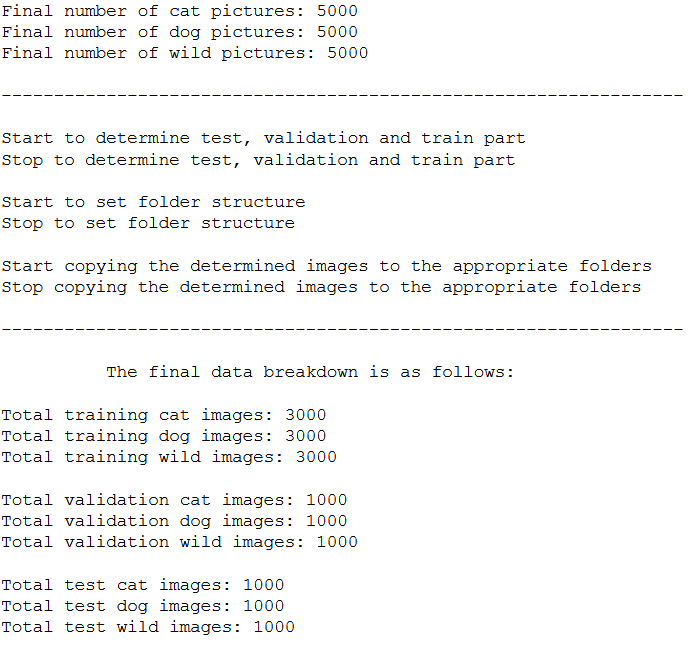
3.2 Obtaining the lists of randomly selected images
list_cats_training = c_train
list_dogs_training = d_train
list_wilds_training = w_train
list_cats_validation = c_val
list_dogs_validation = d_val
list_wilds_validation = w_val
list_cats_test = c_test
list_dogs_test = d_test
list_wilds_test = w_test3.3 Determination of the directories
root_directory = os.getcwd()
train_dir = os.path.join(root_directory, 'animals\\train')
validation_dir = os.path.join(root_directory, 'animals\\validation')
test_dir = os.path.join(root_directory, 'animals\\test')3.4 Obtain the total number of training, validation and test images
num_cats_img_train = len(list_cats_training)
num_dogs_img_train = len(list_dogs_training)
num_wilds_img_train = len(list_wilds_training)
num_train_images_total = num_cats_img_train + num_dogs_img_train + num_wilds_img_train
print('Total training cat images: ' + str(num_cats_img_train))
print('Total training dog images: ' + str(num_dogs_img_train))
print('Total training wild images: ' + str(num_wilds_img_train))
print()
print('Total training images: ' + str(num_train_images_total))
num_cats_img_validation = len(list_cats_validation)
num_dogs_img_validation = len(list_dogs_validation)
num_wilds_img_validation = len(list_wilds_validation)
num_validation_images_total = num_cats_img_validation + num_dogs_img_validation + num_wilds_img_validation
print('Total validation cat images: ' + str(num_cats_img_validation))
print('Total validation dog images: ' + str(num_dogs_img_validation))
print('Total validation wild images: ' + str(num_wilds_img_validation))
print()
print('Total validation images: ' + str(num_validation_images_total))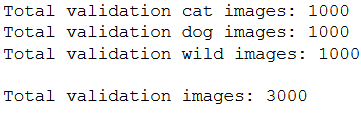
num_cats_img_test = len(list_cats_test)
num_dogs_img_test = len(list_dogs_test)
num_wilds_img_test = len(list_wilds_test)
num_test_images_total = num_cats_img_test + num_dogs_img_test + num_wilds_img_test
print('Total test cat images: ' + str(num_cats_img_test))
print('Total test dog images: ' + str(num_dogs_img_test))
print('Total test wild images: ' + str(num_wilds_img_test))
print()
print('Total test images: ' + str(num_test_images_total))
4 Feature Extraction with Data Augmentation
4.1 Name Definitions
checkpoint_no = 'ckpt_1_CNN_with_TF_VGG19_with_DataAug'
model_name = 'Animals_CNN_TF_VGG19_epoch_30_ES'4.2 Parameter Settings
img_height = 150
img_width = 150
input_shape = (img_height, img_width, 3)
n_batch_size = 32
n_steps_per_epoch = int(num_train_images_total / n_batch_size)
n_validation_steps = int(num_validation_images_total / n_batch_size)
n_test_steps = int(num_test_images_total / n_batch_size)
n_epochs = 30
num_classes = len(os.listdir(train_dir))
print('Input Shape: '+'('+str(img_height)+', '+str(img_width)+', ' + str(3)+')')
print('Batch Size: ' + str(n_batch_size))
print()
print('Steps per Epoch: ' + str(n_steps_per_epoch))
print()
print('Validation Steps: ' + str(n_validation_steps))
print('Test Steps: ' + str(n_test_steps))
print()
print('Number of Epochs: ' + str(n_epochs))
print()
print('Number of Classes: ' + str(num_classes))
4.3 Instantiating the VGG19 convolutional base
VGG19_base = VGG19(weights='imagenet',
include_top=False,
input_shape=input_shape)
conv_base = VGG19_baseconv_base.summary()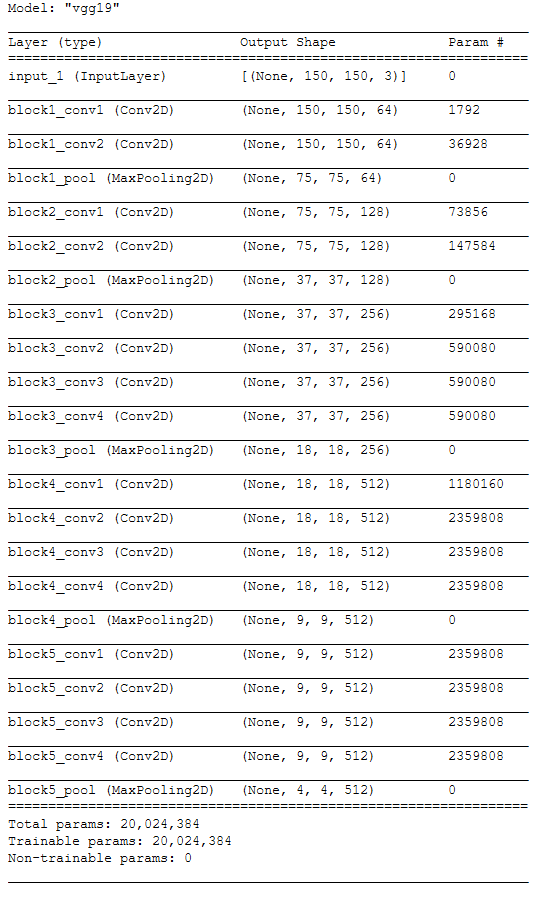
4.4 Instantiating a densely connected classifier
4.4.1 Layer Structure
model = models.Sequential()
model.add(conv_base)
model.add(layers.Flatten())
model.add(layers.Dense(256, activation='relu'))
model.add(layers.Dense(num_classes, activation='softmax'))model.summary()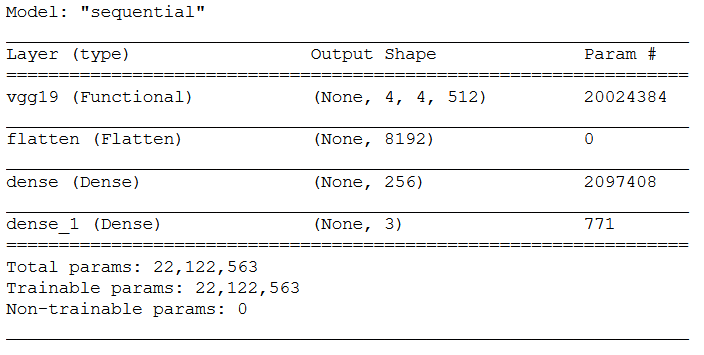
print('Number of trainable weights before freezing the conv base:', len(model.trainable_weights))
conv_base.trainable = False
model = models.Sequential()
model.add(conv_base)
model.add(layers.Flatten())
model.add(layers.Dense(256, activation='relu'))
model.add(layers.Dense(num_classes, activation='softmax'))model.summary()
print('Number of trainable weights after freezing the conv base:', len(model.trainable_weights))
4.4.2 Configuring the model for training
model.compile(loss='categorical_crossentropy',
optimizer='adam',
metrics=['accuracy'])4.4.3 Using ImageDataGenerator
train_datagen = ImageDataGenerator(
rescale=1./255,
rotation_range=40,
width_shift_range=0.2,
height_shift_range=0.2,
shear_range=0.2,
zoom_range=0.2,
horizontal_flip=True,)
validation_datagen = ImageDataGenerator(rescale=1./255)
train_generator = train_datagen.flow_from_directory(
train_dir,
target_size=(img_height, img_width),
batch_size=n_batch_size,
class_mode='categorical')
validation_generator = validation_datagen.flow_from_directory(
validation_dir,
target_size=(img_height, img_width),
batch_size=n_batch_size,
class_mode='categorical')
4.5 Callbacks
# Prepare a directory to store all the checkpoints.
checkpoint_dir = checkpoint_no
if not os.path.exists(checkpoint_dir):
os.makedirs(checkpoint_dir)keras_callbacks = [ModelCheckpoint(filepath = checkpoint_dir,
monitor='val_loss', save_best_only=True, mode='auto'),
EarlyStopping(monitor='val_loss', patience=5, mode='auto',
min_delta = 0, verbose=1)]4.6 Fitting the model
history = model.fit(
train_generator,
steps_per_epoch=n_steps_per_epoch,
epochs=n_epochs,
validation_data=validation_generator,
validation_steps=n_validation_steps,
callbacks=keras_callbacks)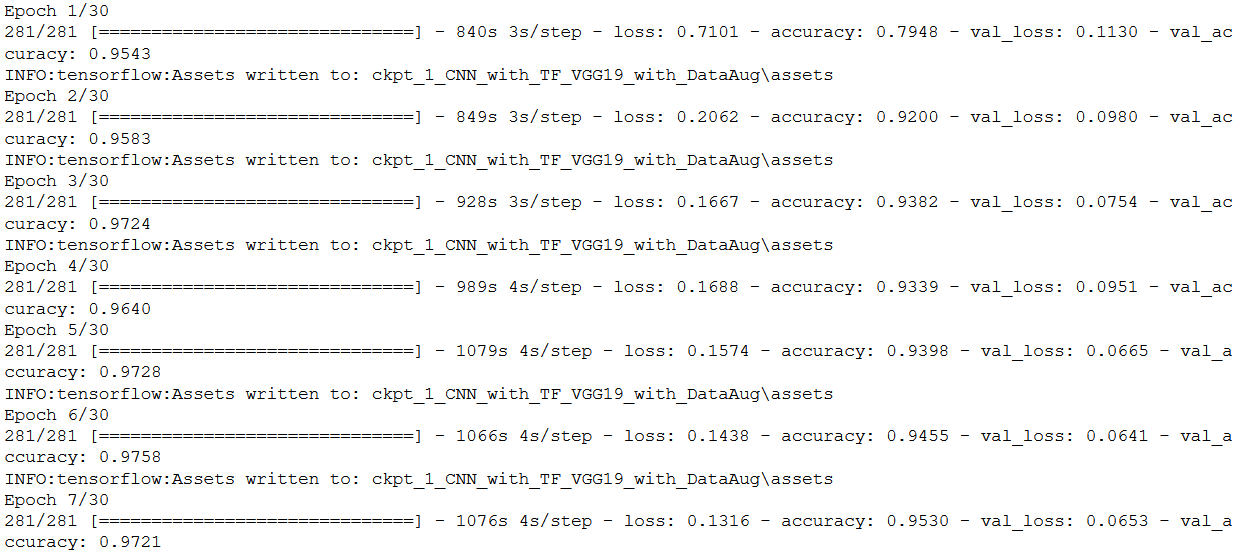
4.7 Obtaining the best model values
hist_df = pd.DataFrame(history.history)
hist_df['epoch'] = hist_df.index + 1
cols = list(hist_df.columns)
cols = [cols[-1]] + cols[:-1]
hist_df = hist_df[cols]
hist_df.to_csv(checkpoint_no + '/' + 'history_df_' + model_name + '.csv')
hist_df.head()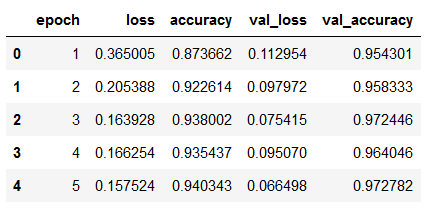
values_of_best_model = hist_df[hist_df.val_loss == hist_df.val_loss.min()]
values_of_best_model
4.8 Obtaining class assignments
class_assignment = train_generator.class_indices
df = pd.DataFrame([class_assignment], columns=class_assignment.keys())
df_stacked = df.stack()
df_temp = pd.DataFrame(df_stacked).reset_index().drop(['level_0'], axis=1)
df_temp.columns = ['Category', 'Allocated Number']
df_temp.to_csv(checkpoint_no + '/' + 'class_assignment_df_' + model_name + '.csv')
print('Class assignment:', str(class_assignment))
4.9 Validation
acc = history.history['accuracy']
val_acc = history.history['val_accuracy']
loss = history.history['loss']
val_loss = history.history['val_loss']
epochs = range(1, len(acc) + 1)
plt.plot(epochs, acc, 'bo', label='Training acc')
plt.plot(epochs, val_acc, 'b', label='Validation acc')
plt.title('Training and validation accuracy')
plt.legend()
plt.figure()
plt.plot(epochs, loss, 'bo', label='Training loss')
plt.plot(epochs, val_loss, 'b', label='Validation loss')
plt.title('Training and validation loss')
plt.legend()
plt.show()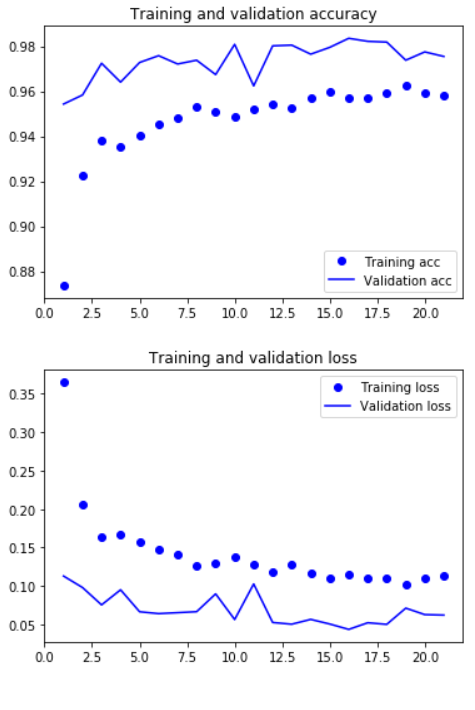
4.10 Load best model
# Loading the automatically saved model
model_reloaded = load_model(checkpoint_no)
# Saving the best model in the correct path and format
root_directory = os.getcwd()
checkpoint_dir = os.path.join(root_directory, checkpoint_no)
model_name_temp = os.path.join(checkpoint_dir, model_name + '.h5')
model_reloaded.save(model_name_temp)
# Deletion of the automatically created folders/.pb file under Model Checkpoint File.
folder_name_temp1 = os.path.join(checkpoint_dir, 'assets')
folder_name_temp2 = os.path.join(checkpoint_dir, 'variables')
file_name_temp = os.path.join(checkpoint_dir, 'saved_model.pb')
shutil.move(file_name_temp, folder_name_temp1)
shutil.rmtree(folder_name_temp1, ignore_errors=True)
shutil.rmtree(folder_name_temp2, ignore_errors=True)best_model = load_model(model_name_temp)4.11 Model Testing
test_datagen = ImageDataGenerator(rescale=1./255)
test_generator = test_datagen.flow_from_directory(
test_dir,
target_size=(img_height, img_width),
batch_size=n_batch_size,
class_mode='categorical')
test_loss, test_acc = best_model.evaluate(test_generator, steps=n_test_steps)
print()
print('Test Accuracy:', test_acc)
For later use, I save all necessary metrics separately.
pk.dump(img_height, open(checkpoint_dir+ '\\' +'img_height.pkl', 'wb'))
pk.dump(img_width, open(checkpoint_dir+ '\\' +'img_width.pkl', 'wb'))Our final folder structure now looks like this:
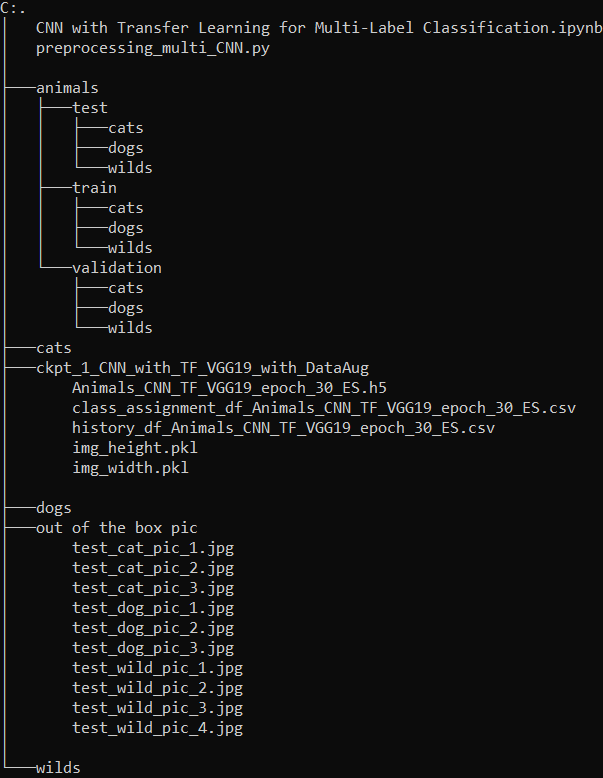
4.12 Test Out of the Box Pictures
# Determine Checkpoint Dir
checkpoint_dir = 'ckpt_1_CNN_with_TF_VGG19_with_DataAug'
# Load best model
best_model = load_model(checkpoint_dir + '/' + 'Animals_CNN_TF_VGG19_epoch_30_ES.h5')
# Load the categories
df = pd.read_csv(checkpoint_dir + '/' + 'class_assignment_df_Animals_CNN_TF_VGG19_epoch_30_ES.csv')
df = df.sort_values(by='Allocated Number', ascending=True)
CATEGORIES = df['Category'].to_list()
# Load the used image height and width
img_height_reload = pk.load(open(checkpoint_dir + '/' + 'img_height.pkl','rb'))
img_width_reload = pk.load(open(checkpoint_dir + '/' + 'img_width.pkl','rb'))
print('Model Summary :' + str(best_model.summary()))
print()
print()
print('CATEGORIES : ' + str(CATEGORIES))
print()
print('Used image height: ' + str(img_height_reload))
print('Used image width: ' + str(img_width_reload))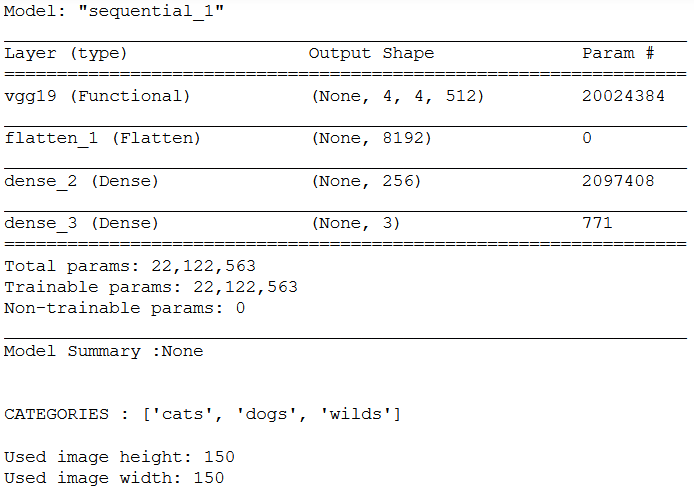
img_pred = cv2.imread('out of the box pic/test_cat_pic_1.jpg')
print(plt.imshow(cv2.cvtColor(img_pred, cv2.COLOR_BGR2RGB)))
img_pred = cv2.resize(img_pred,(img_height_reload,img_width_reload))
img_pred = np.reshape(img_pred,[1,img_height_reload,img_width_reload,3])
classes = np.argmax(best_model.predict(img_pred), axis=-1)
print()
print('------------------------------------')
print('Predicted Class: ' + CATEGORIES[int(classes[0])])
print('------------------------------------')
img_pred = cv2.imread('out of the box pic/test_cat_pic_2.jpg')
print(plt.imshow(cv2.cvtColor(img_pred, cv2.COLOR_BGR2RGB)))
img_pred = cv2.resize(img_pred,(img_height_reload,img_width_reload))
img_pred = np.reshape(img_pred,[1,img_height_reload,img_width_reload,3])
classes = np.argmax(best_model.predict(img_pred), axis=-1)
print()
print('------------------------------------')
print('Predicted Class: ' + CATEGORIES[int(classes[0])])
print('------------------------------------')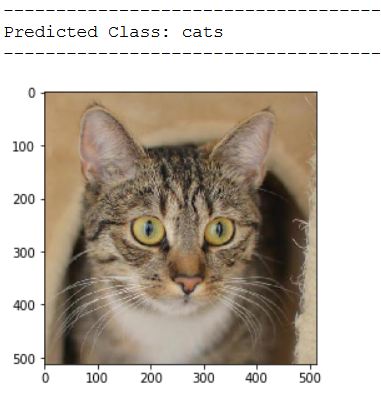
img_pred = cv2.imread('out of the box pic/test_cat_pic_3.jpg')
print(plt.imshow(cv2.cvtColor(img_pred, cv2.COLOR_BGR2RGB)))
img_pred = cv2.resize(img_pred,(img_height_reload,img_width_reload))
img_pred = np.reshape(img_pred,[1,img_height_reload,img_width_reload,3])
classes = np.argmax(best_model.predict(img_pred), axis=-1)
print()
print('------------------------------------')
print('Predicted Class: ' + CATEGORIES[int(classes[0])])
print('------------------------------------')
img_pred = cv2.imread('out of the box pic/test_dog_pic_1.jpg')
print(plt.imshow(cv2.cvtColor(img_pred, cv2.COLOR_BGR2RGB)))
img_pred = cv2.resize(img_pred,(img_height_reload,img_width_reload))
img_pred = np.reshape(img_pred,[1,img_height_reload,img_width_reload,3])
classes = np.argmax(best_model.predict(img_pred), axis=-1)
print()
print('------------------------------------')
print('Predicted Class: ' + CATEGORIES[int(classes[0])])
print('------------------------------------')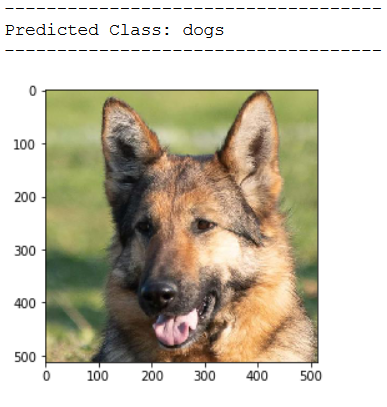
img_pred = cv2.imread('out of the box pic/test_dog_pic_2.jpg')
print(plt.imshow(cv2.cvtColor(img_pred, cv2.COLOR_BGR2RGB)))
img_pred = cv2.resize(img_pred,(img_height_reload,img_width_reload))
img_pred = np.reshape(img_pred,[1,img_height_reload,img_width_reload,3])
classes = np.argmax(best_model.predict(img_pred), axis=-1)
print()
print('------------------------------------')
print('Predicted Class: ' + CATEGORIES[int(classes[0])])
print('------------------------------------')
img_pred = cv2.imread('out of the box pic/test_dog_pic_3.jpg')
print(plt.imshow(cv2.cvtColor(img_pred, cv2.COLOR_BGR2RGB)))
img_pred = cv2.resize(img_pred,(img_height_reload,img_width_reload))
img_pred = np.reshape(img_pred,[1,img_height_reload,img_width_reload,3])
classes = np.argmax(best_model.predict(img_pred), axis=-1)
print()
print('------------------------------------')
print('Predicted Class: ' + CATEGORIES[int(classes[0])])
print('------------------------------------')
img_pred = cv2.imread('out of the box pic/test_wild_pic_1.jpg')
print(plt.imshow(cv2.cvtColor(img_pred, cv2.COLOR_BGR2RGB)))
img_pred = cv2.resize(img_pred,(img_height_reload,img_width_reload))
img_pred = np.reshape(img_pred,[1,img_height_reload,img_width_reload,3])
classes = np.argmax(best_model.predict(img_pred), axis=-1)
print()
print('------------------------------------')
print('Predicted Class: ' + CATEGORIES[int(classes[0])])
print('------------------------------------')
img_pred = cv2.imread('out of the box pic/test_wild_pic_2.jpg')
print(plt.imshow(cv2.cvtColor(img_pred, cv2.COLOR_BGR2RGB)))
img_pred = cv2.resize(img_pred,(img_height_reload,img_width_reload))
img_pred = np.reshape(img_pred,[1,img_height_reload,img_width_reload,3])
classes = np.argmax(best_model.predict(img_pred), axis=-1)
print()
print('------------------------------------')
print('Predicted Class: ' + CATEGORIES[int(classes[0])])
print('------------------------------------')
img_pred = cv2.imread('out of the box pic/test_wild_pic_3.jpg')
print(plt.imshow(cv2.cvtColor(img_pred, cv2.COLOR_BGR2RGB)))
img_pred = cv2.resize(img_pred,(img_height_reload,img_width_reload))
img_pred = np.reshape(img_pred,[1,img_height_reload,img_width_reload,3])
classes = np.argmax(best_model.predict(img_pred), axis=-1)
print()
print('------------------------------------')
print('Predicted Class: ' + CATEGORIES[int(classes[0])])
print('------------------------------------')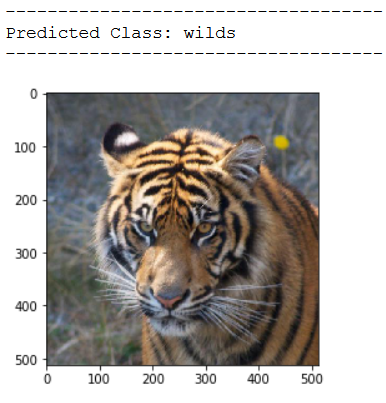
5 Conclusion
In addition to my post Computer Vision - CNN with Transfer Learning I have shown here how to use pre-trained neural networks to solve multiple classification problems.
6 Link to the GitHub Repository
Here is the link to my GitHub repository where I have listed all necessary steps: CV-CNN-with-Transfer-Learning-for-Multi-Class-Classification
References
The content of the entire post was created using the following sources:
Chollet, F. (2018). Deep learning with Python (Vol. 361). New York: Manning.